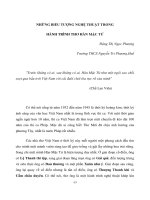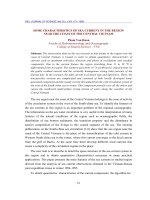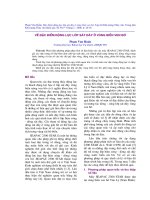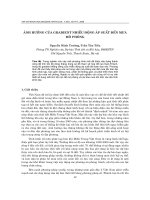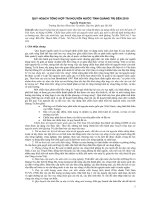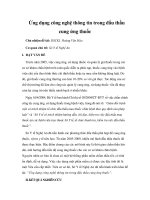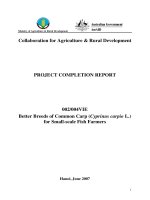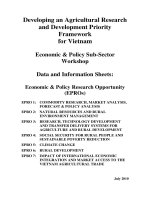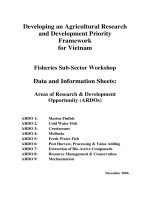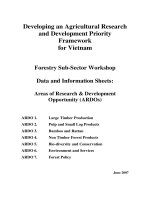Báo cáo nghiên cứu khoa học " Better Breeds of Common Carp (Cyprinus carpio L.) for Small-scale Fish Farmers " doc
Bạn đang xem bản rút gọn của tài liệu. Xem và tải ngay bản đầy đủ của tài liệu tại đây (70.52 KB, 7 trang )
Ministry of Agriculture & Rural Development
Collaboration for Agriculture & Rural Development
PROJECT COMPLETION REPORT
002/004VIE
Better Breeds of Common Carp (Cyprinus carpio L.)
for Small-scale Fish Farmers
Hanoi, June 2007
1
1. Institute Information
Project Name
Better Breeds of Common carp (Cyprinus
carpio L.) for Small-scale Fish Farmers
Vietnamese Institution
Research Institute for Aquaculture No.1
Vietnamese Project Team Leader
Dr Tuan Anh Pham
Australian Organisation
Charles Darwin University
Australian Personnel
Prof. Chris Austin
Date commenced
8 March, 2005
Completion date (original)
8 March, 2007
Completion date (revised)
8 June, 2007
Contact Officer(s)
In Australia: Team Leader
Name:
Dr Chris Austin
Telephone:
08 8946 7276
Position:
Professor/HOS
Fax:
08 8946 6151
Organisation
Charles Darwin
University
Email:
In Australia: Administrative contact
Name:
Dr Jenny Carter
Telephone:
08 8946 6708
Position:
Manager Research
Fax:
08 8946 7199
Organisation
Charles Darwin University
Email:
In Vietnam
Name:
Dr Tuan Anh Pham
Telephone:
84 4 8781084
Position:
Deputy Director
Fax:
84 4 8273070
Organisation
Research Institute for Aquaculture No. 1
Email:
patuan.2006@yahoo.
com
2
2. Project Abstract
Increased inland fish production is a high priority for the Government of Vietnam
particularly in the context of rural development in relation to food security, poverty
alleviation and income generation. Genetic improvement of fish species has been
identified as a priority area for research and development. The general aim of this two
year-project is to assist the continued development of genetically improved Common
Carp (Cyprinus carpio L.) breeds, the effective dissemination of these breeds from central
research institutes to provincial hatcheries for distributions to small scale farmers and
further development of research capacity in genetics in relation to selective breeding and
brood-stock management.
Almost all inputs of project have been achieved and all milestones have been met
or exceeded. Samples of common carp have been collected from a large number of
locations and genetically analysed. Genetic differences between genetically improved
breeds, provincial hatchery broodstock and farmed stocks determined. Technical training
workshops for common carp hatchery managers and small scale farmers were conducted.
Technical training for young Vietnamese researchers in the use and application of
advanced genetic principles and techniques in fish breeding and genetic improvement
studies has been carried out in both Vietnam and Australia. On-farm grow-out trials to
compare genetically improved breeds and locally available strains of common carp were
conducted in various low-input–small scale aquaculture systems. The better breed of
common carp has been identified and disseminated to fish farmers.
3. Executive Summary
Excellent progress has been made with this two year project (March 2005 to
June 2007). Almost all outputs of the project have been achieved and all milestones
have been met or exceeded that were planned. Current common carp breeding
practices and broodstock management were surveyed and reviewed. Knowledge
levels of fish breeding and hatchery operation among fish farmers and hatchery
personnel have been assessed. Thirty populations of common carp have been
collected from research stations, provincial hatcheries, private hatcheries farmers and
wild populations. Genetic variation of the collected populations were analysed. These
results reveal important insights into the effects of inbreeding and dissemination of
genetically improved strains. Research results have been reported in two publications
in the international journal Aquaculture.
Two training workshops on common carp breeding, broodstock management
and seed production were conducted for 70 hatchery personnel and fish farmers.
Important stakeholder views and opinions on common carp breeds were obtained
from these key stakeholders. Technical training on fish breeding principles and
techniques of molecular analysis for 20 Vietnamese young scientists from research
institutes and universities was carried out, and intensive training for 4 Vietnamese
young scientists on advanced molecular techniques were undertaken in Deakin
University and Charles Darwin University in Australia. Growth performance of
3
common carp from different strains have been evaluated in farmers’ ponds in Thai
Nguyen and Yen Bai provinces. Information on the best breeds of common carps for
small-scale, low inputs aquaculture systems were identified and used to advise
farmers in relation to choosing carp broodstock, fry and fingerlings.
4. Introduction & Background
The general aim of this project is to identify better breeds of common carp and
increase the utilisation of such fish by small-scale farmers as means of increasing
yields and lowering costs, and thereby contributing significantly to poverty alleviation
and income generation for communities heavily dependent on fish aquaculture for
livelihoods and food security.
Common carp was chosen as the target species as it is the most important
cultured fish species in Vietnam (approximately 20,000 metric tons produced per
year) with a very large number of people, including those in low income regions (e.g.
highlands) and ethnic minorities, dependent upon it for food security and income.
Further, the Vietnamese Government has in the past, and continues to invest
significant resources into the production and dissemination of genetically improved
breeds of this species, and there is significant local expertise in the area of genetics
and breeding (e.g. staff of the Research Institute for Aquaculture No. 1).
The specific objectives of this project are to: (1) document current fish
breeding and brood-stock management practices in relation to the selection and
maintenance of genetically improved common carp breeds at the institutional,
hatchery (provincial and private) and small-scale farm levels; to assess knowledge
levels relating to fish breeds and selection of seed stock by small scale farmers; (2)
determine genotypic and phenotypic diversity among common carp genetic resources
(breeds), both wild and domesticated, available for aquaculture within Vietnam and
examine the success of dissemination of genetically improved breeds to small scale
farmers; (3) increase success and efficiency of common carp breeding, broodstock
management and seed stock production by small scale farmers and hatchery
personnel; (4) increase capacity of young researchers and technicians to contribute to
research and development in the fields of genetics of broodstock management,
molecular genetics and fish genetic improvement; and (5) demonstrate to farmers, on
farm, the advantages of using genetically improved breeds of common carp.
The approach adopted for this project involves a novel combination of
traditional and modern methods. Thus the understanding of common carp genetic
resources in Vietnam and the success of the dissemination of genetically improved
breeds to small-scale farmers will be based on the use of modern (molecular genetic)
and traditional phenotypic (morphological, pond growth trials) approaches, and
through demonstration (by stocking improved fish breeds into farmers ponds) and by
interviewing stakeholders. Also a more ‘de-centralised’ approach to both
understanding carp genetic resources will be taken using comprehensive geographic
sampling of domesticated and wild populations and through capacity building for
provincial hatcheries (via training programs) to enable better brood-stock
management and improve fish breeding.
4
5. Progress to Date
5.1 Implementation Highlights
The principal achievements for the project have been:
(1) A total of 133 farmers and hatchery personnel were interviewed to determine
knowledge levels relating to fish breeding and genetic improvement and
common carp breeding practises by small scale fish farmers and hatchery
personnel. Data was analysed and summarised.
(2) The successful training of four young scientists from the Research Institute for
Aquaculture No.1, Research Institute for Aquaculture No.3 and from
University of Fisheries, Nha Trang at Deakin University and Charles Darwin
University in advanced genetic technologies and statistical procedures.
(3) Technical training on fish breeding principles and molecular analysis
application in genetic improvement of fish for 20 Vietnamese young scientists
from research institutes and universities was successfully carried out at the
Research Institute for Aquaculture No.1 (Vietnam).
(4) The two workshops for farmers were organised in RIA1, (Bac Ninh), Thai
Nguyen Aquaculture Centre (Thai Nguyen province) and at National
Broodstock Center (NBC) of RIA-I with 70 participants (see workshop
materials). Important information relevant to the management of the
Government carp breeding programs and dissemination of genetically
improved stocks emerged from the workshops and stakeholder consultations.
(5) Samples of 30 common carp populations were obtained from research stations,
provincial hatcheries, private hatcheries farmers, markets and wild populations
thoughout Vietnam which has exceeded expectations.
(6) Genetic variation of the collected 30 common carp populations were analysed
and published in peer reviewed Journal.
(7) The on-farm trails of improved and locally available strains of common carp
have been carried at 40 farmers involved 10,000 of fish stocked in the farms,
34 of ponds, and 6 rice fields.
5.2 Smallholder Benefits
The most direct benefits to small-scale fish farmers to date have been through
the workshops run at the Thai Nguyen Fish Extension Centre and at National
Broodstock Center (NBC) of RIA-I in Hai Duong for fish farmers and hatchery
personnel. The knowledge of fish farmers about common carp breeding and culture
was significantly improved. Very successful was the demonstrated for modern
controlled breeding techniques at the NBC as many farmers had not been exposed to
5
these methods before. The workshop was successful in communicating the
Government’s strategy for improving carp productivity and in encouraging farmers to
participate in the on-farm trials. The workshop was also successful in encouraging
farmers to compare farming strategies and to learn from each other.
The better breeds of common carp for aquaculture in fish farmer’s systems
was identified through the on farm trials. The on farm trials also effectively re-
inforced among farmers the importance of considering the performance of different
breeds of fish in their ponds. The results of the on-farm trials provided a basis for the
provision of advice to farmers on the better breeds for fish producers (both growth-out
and hatchery operators) in two target project provinces: Thai Nguyen and Yen Bai.
5.3 Capacity Building
A contribution to capacity building at the institutional level has been made
through technical training on fish breeding principles and molecular analysis
application in genetic improvement of fish for 20 Vietnamese young scientists from
research institutes and universities and the advanced training programs delivered to
four young scientists at Deakin University and Charles Darwin University in
Australia.
5.4 Publicity
There are 3 scientific papers published at International peer review Journal
and information is to be disseminated through information pamphlets and newsletters
in Vietnam.
5.5 Project Management
Management of the project as been effective.
6. Report on Cross-Cutting Issues
6.1 Environment
No issues to report.
6.2 Gender and Social Issues
No issues to report.
7. Implementation & Sustainability Issues
7.1 Issues and Constraints
The implementation of the project has been complicated by the movement of
staff and unanticipated demands from other projects for the Australian partner. These
6
problems have been overcome by accessing the services of other personnel or in some
cases increasing the time commitments of nominated staff.
The project completion can not meet at the planned milestone due to two
major issues arisen. These are (i) Dr Chris M. Austin, Australian team leader, has
been appointed to the position of Professor and Head of School of the School of
Science and Primary Industries at Charles Darwin University, Darwin, Australia. He
was transferred to Darwin from Deakin University in November 2005.
And (ii) the final on-farm trail to compare growth performance of the
improved common carp and locally available strains conduced in two highland
provinces (Thai Nguyen & Yen Bai) could not complete as planned. The harvesting of
pond trials from some farmers’ ponds had to be left for significantly longer period of
time than anticipated as fish were displaying very slow growth rates due to low inputs
and higher stocking rates. Further, the draining of ponds for harvesting could only be
done when convenient for some farmers due to the lack of availability of water. Some
fish was delayed to harvest until late March 2007.
7.2 Options
7.3 Sustainability
No major issues other than those indicated above.
8. Next Critical Steps
The next steps are:
(1) To ensure the dissemination of the results and findings to the full range of
stakeholders and partners, especially small scale fish farmers in north Vietnam
(2) Extend the model of on farm trials, which involved the effective engagements
of farmers in the trials to identify better fish breeds, to other provinces and fish
species.
(3) Publish the results of the on farm trials in aquaculture magazines and journals
as a case study of evidence-based and participatory research in aquaculture.
9. Conclusion
Progress of this project has been highly satisfactory and almost all objectives
established for the project have been met or exceeded.
7
